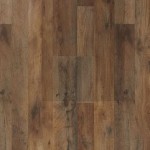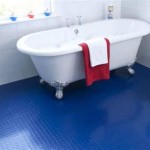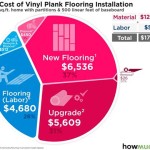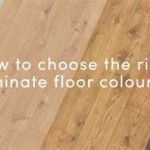Removing Linoleum Flooring From Concrete: A Comprehensive Guide
Linoleum flooring, once a popular and cost-effective choice, is frequently encountered in older homes and buildings. While durable, linoleum eventually requires replacement due to wear and tear, damage, or aesthetic preferences. Removing linoleum adhered to a concrete subfloor presents a unique set of challenges compared to installations over wood. The tenacious adhesive used to bond the linoleum to the concrete can make the removal process labor-intensive and require specialized tools and techniques.
This article provides a detailed guide on how to effectively and safely remove linoleum flooring from concrete. It covers the necessary preparation, the tools required, various removal methods, and essential steps for preparing the concrete subfloor for a new flooring installation. Success in this project depends on careful planning, accurate execution, and adherence to safety protocols.
Preparation is Key
Before commencing the linoleum removal process, thorough preparation is critical. This involves assessing the scope of the project, gathering the appropriate tools and safety equipment, and preparing the work area. A well-prepared workspace not only streamlines the removal process but also minimizes potential hazards and ensures a more efficient outcome.
Assessing the Project. The initial step involves carefully inspecting the linoleum flooring. Note the type of adhesive used, if discernible. Older installations often used asbestos-containing adhesives, which requires special handling by certified professionals. Determine the overall condition of the linoleum and the extent of the area to be removed. Inspect for any signs of moisture damage or mold growth, which may require addressing before proceeding with the removal. Documenting these initial observations will inform the subsequent steps and help in selecting the most appropriate removal method.
Gathering Tools and Materials. A successful linoleum removal project necessitates having the right tools and materials readily available. Essential tools include a floor scraper (both long-handled and hand-held), a utility knife with durable blades, a heat gun or hair dryer, a pry bar, a hammer, a chisel, and a sturdy bucket or trash bags for disposal. Consider renting a floor scraper machine for large areas. In addition to tools, gather necessary materials such as adhesive remover (specifically formulated for linoleum and concrete), heavy-duty garbage bags, and cleaning supplies. Select an adhesive remover compatible with the type of adhesive used, if known, and ensure proper ventilation during its application.
Safety Precautions and Protective Gear. Safety must be the paramount concern throughout the linoleum removal process. Linoleum and its adhesive can contain potentially harmful substances, and the removal process can generate dust and debris. Wear appropriate personal protective equipment (PPE), including safety glasses or goggles to protect the eyes from flying debris, heavy-duty work gloves to safeguard the hands from cuts and abrasions, and a respirator or dust mask to prevent the inhalation of dust particles and fumes from the adhesive remover. Ensure adequate ventilation in the work area by opening windows or using a fan to circulate air. Protect the surrounding areas from dust and debris by covering them with plastic sheeting or drop cloths. If asbestos is suspected, immediately cease work and contact a certified asbestos abatement professional.
Linoleum Removal Methods
Several methods can be employed to remove linoleum flooring from concrete, each with its own advantages and disadvantages. The choice of method depends on factors such as the size of the area, the type of adhesive used, the condition of the linoleum, and the available tools and resources. A combination of methods may be necessary to achieve complete removal.
The Heat Method. Applying heat to the linoleum can soften the adhesive, making it easier to scrape away. This method is particularly effective for older adhesives that have become brittle over time. Using a heat gun or hair dryer, apply heat to a small section of the linoleum for several seconds, moving the heat source back and forth to avoid overheating or scorching the material. Once the linoleum is sufficiently heated, use a floor scraper or putty knife to lift and peel away the softened material. Work in small sections, reheating as needed, to gradually remove the linoleum. Be cautious when using a heat gun, as it can generate high temperatures and pose a fire hazard. Always keep the heat gun moving and avoid concentrating the heat on one spot for too long.
The Scraping Method. This method involves using a floor scraper to manually remove the linoleum from the concrete subfloor. This is often the most straightforward approach, but it can be physically demanding, especially for large areas. Begin by scoring the linoleum with a utility knife along its seams or in a grid pattern to create smaller, more manageable sections. Using a long-handled floor scraper, position the blade at a low angle against the linoleum and apply firm, even pressure to peel it away from the concrete. For stubborn areas, a hand-held scraper in conjunction with a hammer or a pry bar can provide added leverage. Take caution to avoid gouging or damaging the concrete subfloor during the scraping process. Maintaining a consistent angle and applying steady pressure will help to minimize damage and ensure a smoother removal.
The Adhesive Remover Method. Chemical adhesive removers can dissolve or soften the adhesive, making it easier to scrape or peel away the linoleum. Select an adhesive remover specifically formulated for linoleum and concrete, and follow the manufacturer's instructions carefully. Before applying the adhesive remover to the entire area, test it on a small, inconspicuous section to ensure that it does not damage the concrete or cause discoloration. Apply the adhesive remover evenly over the linoleum, allowing it to dwell for the recommended time (usually several minutes). The dwell time allows the chemicals to penetrate and break down the adhesive. After the dwell time, use a floor scraper or putty knife to remove the softened linoleum. Repeat the application as needed for stubborn areas. Ensure proper ventilation and wear appropriate PPE, as adhesive removers can emit strong fumes.
Preparing the Concrete Subfloor
Once the linoleum has been removed, preparing the concrete subfloor is essential for ensuring a smooth and successful installation of the new flooring. This involves removing any remaining adhesive residue, repairing cracks or imperfections, and leveling the surface to create a uniform and stable foundation.
Removing Adhesive Residue. Even after the linoleum has been removed, adhesive residue will likely remain on the concrete subfloor. This residue must be thoroughly removed to ensure proper adhesion of the new flooring. Several methods can be used to remove adhesive residue, including chemical adhesive removers, mechanical scraping, and grinding. Applying additional adhesive remover, as described earlier, can effectively dissolve or soften the remaining residue. A floor scraper or putty knife can then be used to scrape away the softened adhesive. For stubborn residue, a concrete grinder with an appropriate grinding pad may be necessary. A grinder can effectively remove adhesive residue, but it can also generate significant dust, so proper ventilation and respiratory protection are crucial. Alternatively, a citrus-based adhesive remover can be used as an environmentally friendly option, though it may require more dwell time and effort to remove the residue.
Repairing Cracks and Imperfections. Concrete subfloors often have cracks, holes, or other imperfections that need to be repaired before installing new flooring. These imperfections can compromise the stability and appearance of the new flooring. Use a concrete patching compound specifically designed for filling cracks and repairing damaged concrete. Clean the cracks or holes thoroughly, removing any loose debris or dust. Apply the patching compound according to the manufacturer's instructions, ensuring that it fills the entire crack or hole. Use a trowel to smooth the surface of the patching compound and allow it to dry completely before proceeding. For larger cracks or damaged areas, multiple applications of the patching compound may be necessary.
Leveling the Surface. A level subfloor is essential for a professional-looking and long-lasting flooring installation. If the concrete subfloor is uneven, it may be necessary to apply a self-leveling compound to create a smooth and level surface. Self-leveling compounds are cement-based mixtures that are poured onto the subfloor and allowed to flow and self-level. Follow the manufacturer's instructions carefully when mixing and applying the self-leveling compound. Ensure that the compound is poured evenly and that it covers the entire area. Use a gauge rake or notched trowel to help spread the compound and remove any air bubbles. Allow the self-leveling compound to dry completely before proceeding with the new flooring installation. The drying time will vary depending on the product and the ambient temperature and humidity.

Easiest Way Of Removing Linoleum From Concrete

How To Remove Old Vinyl Or Linoleum Flooring Kitchens And Bathrooms

The Fastest Way To Remove Bonded Vinyl Flooring From Concrete

How To Remove Linoleum Adhesive From A Concrete Floor

The Easiest Way To Remove Linoleum From Concrete

Removing Linoleum Flooring Glue From Concrete Floor

What You Should Know About Removing Old Linoleum Or Vinyl Flooring Hq Longwood Fl

Easiest Way Of Removing Linoleum From Concrete

How To Finish Removing Linoleum Adhesive For Tile On Concrete Floor Hometalk

How To Easily Remove Linoleum Houseful Of Handmade
Related Posts








